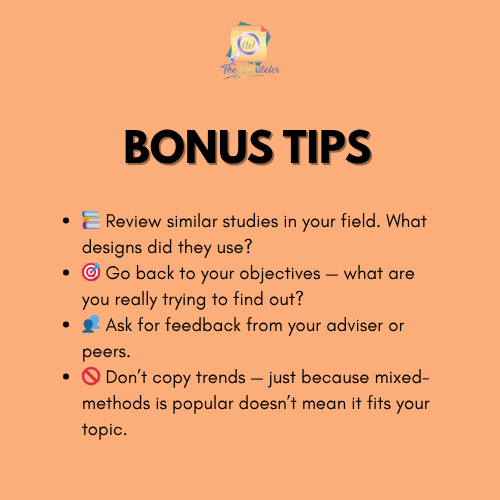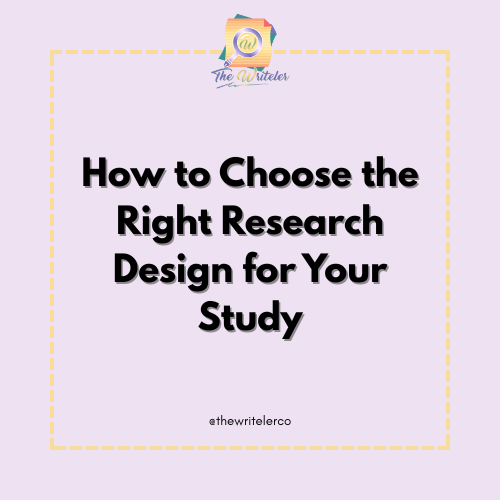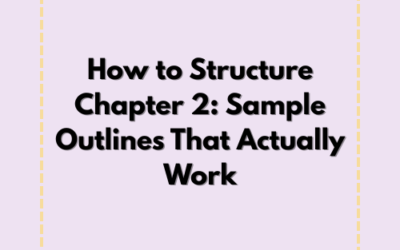One of the most important — and often most confusing — decisions you’ll make in your research journey is choosing the right research design. It’s not just a formality for Chapter 3 of your thesis or dissertation — it determines how you collect data, how you analyze it, and whether your findings will answer your research questions.
Whether you’re a student, a business professional pursuing graduate studies, or deep into your Ph.D., this blog will guide you in selecting a research design that’s aligned, defensible, and efficient.
What is a Research Design?
Think of your research design as your blueprint — a clear plan for how you’ll investigate your topic.
It answers the questions:
- What type of data do I need?
- How will I collect it?
- What’s the best strategy to reach valid conclusions?
⚠️ Don’t confuse research design with research method:
- Design = overall plan (e.g., experimental, descriptive)
- Method = specific technique (e.g., surveys, interviews)
How to Choose the Right Design: 5 Key Factors
Before you commit to a design, consider these:
✅ 1. What is Your Research Question or Objective?
Are you trying to:
- Explore a lived experience? → Qualitative
- Measure something? → Quantitative
- Understand both the numbers and the story? → Mixed-methods
✅ 2. What Are Your Variables?
- Measurable variables? → Consider correlational or experimental
- Abstract concepts like emotions or perceptions? → Lean toward qualitative
✅ 3. What Type of Data Do You Need?
- Numbers, percentages, statistical significance? → Quantitative
- Stories, opinions, themes? → Qualitative
✅ 4. What Are Your Resources?
- Do you have access to a large sample and time for controlled testing?
- Or limited time and access, suitable for interviews or case studies?
✅ 5. What Are the Ethical and Practical Considerations?
- Can you ethically manipulate variables or expose participants to interventions?
- Would passive observation be more appropriate?
Types of Research Designs You Can Use
📊 Quantitative Designs
These focus on measurable data and often involve larger sample sizes.
- Descriptive – Answers “What is happening?” (e.g., surveys)
- Correlational – Measures the relationship between two variables (e.g., social media use and academic performance)
- Experimental – Tests cause-and-effect with controlled conditions (e.g., effects of a training program on productivity)
- Quasi-experimental – Similar to experimental but lacks full control (often used in education or business)
📚 Qualitative Designs
These dive deep into subjective experiences and meaning.
- Phenomenological – Explores lived experiences (e.g., nurses dealing with burnout)
- Case Study – In-depth analysis of a single case or group (e.g., a startup’s marketing evolution)
- Ethnographic – Immersive research into cultural or social settings
- Grounded Theory – Develops theory based on emerging data
🔀 Mixed-Methods
Best when neither quantitative nor qualitative alone is enough.
- Combine surveys (quant) with interviews (qual)
- Great for capturing both statistical trends and personal perspectives
Matching Designs to Real-World Examples
🧪 Example 1: Measuring Impact
Research Topic: Does virtual tutoring improve test scores?
Best Fit: Quasi-experimental design
Why? You’re testing an intervention but may not have full control over variables.
💬 Example 2: Understanding Experiences
Research Topic: How do entrepreneurs in rural areas cope with failure?
Best Fit: Phenomenological design
Why? You’re exploring lived emotional and psychological experiences.
📱 Example 3: Exploring Relationships
Research Topic: Is there a link between screen time and sleep quality in teens?
Best Fit: Correlational design
Why? You want to explore the association without manipulating any variable.

Remember: A clear design leads to clear data — and clear conclusions.
Common Mistakes to Avoid
🚫 Choosing the design based on ease, not alignment.
🚫 Using experimental designs without randomization or control groups.
🚫 Calling it mixed-methods but not truly integrating the data.
🚫 Skipping the justification of your design in Chapter 3.
Always explain why your chosen design is the best fit for your research — reviewers and panels will ask.
Final Thoughts
Choosing the right research design isn’t just a technical requirement — it’s the foundation of your entire study.
It determines what questions you can answer, how confidently you can answer them, and how much impact your study can create.
Take your time. Be intentional. Make your design work for you — not against you.
📣 Need Help Choosing the Right Design?
The Writeler Co. is here to support students and professionals who are juggling research with work, life, and business. Whether you’re writing a thesis, capstone, or dissertation for your master’s or Ph.D., we help you efficiently navigate the research journey — from brainstorming to proofreading.
📩 Message us today to get started.
📚 Let’s turn your research idea into a powerful paper.





0 Comments